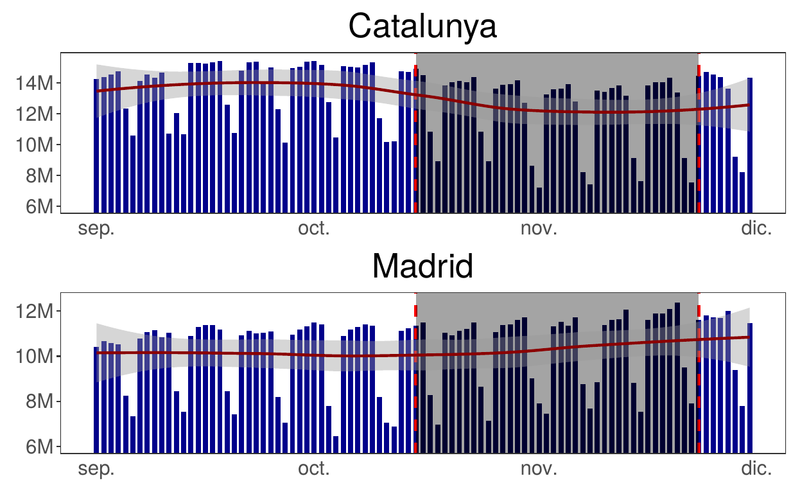This work can assist in the decision making of public policy makers that aim to protect citizens against similar situations in the future.
The policy of closing bars and restaurants was applied across Catalonia between October and November 2020 and it brought with it a noticable reduction in the mobility of people, in fact it translated into a statistically significant reduction in the growth of COVID-19 cases. This is the main conclusion that a recent study at the Barcelona Supercomputing Center Centro - Nacional de Supercomputación (BSC) found. Published in the journal, Scientific Reports, led by investigators Matthew Smith, Miguel Ponce De Leon and Alfonso Valencia.
This work can aid public policy decision making focused on scientific results which serve to protect citizens against similar outbrekas in the future. In order to carry out the study, a dataset from the COVID-19 FlowMaps platform was used. Created by the BSC, it includes, among other things, data on anonomised mobility of mobile phones released by the Ministerio de Transportes y Agenda Urbana de España (MITMA) and COVID19 data released by each respective autonomous community (CCAA).
The study compares the differences in mobility with the evolution of COVID-19 observed during 5 weeks between Barcelona and Madrid (among other CCAA’s). Madrid was chosen as the focus control group in the analysis due to the fact that it did not apply the same restrictions in any of the periods under analysis. The results indicate that the measures adopted by the Catalan Government had impacted the mobility of people which, naturally, reduced more on weekends than weekdays. The results suggest, furthermore, that the policy caused the citizens to change their behaviour patterns in reaction to the policy. That is, people did not substitute meeting with friends and family in bars and restaurants (after the closure of these establishments) with other activities away from their homes, but many opted to remain closer at home.
In order to carry out the study, the department of Life Sciences at the BSC used anaomised mobile phone data in order to calculate the total number of daily trips, going to, from and within a municipal and district. In order to calculate the growth rate of COVID-19 cases in each region, data was used on the number of daily COVID-19 cases reported by the Servicio Catalán de Salud (Catalan Health Service).
Given that the spreading of COVID19 transmites person to person, a larger interaction of individuals may suggest an increase in the effective growth of SARS-CoV-2. Having in mind that the number of social contacts is private data, one cannot estimate this directly, in the study, anonomised mobile phone data was used as a proxy for the level of interactions between people. With this proxy, a reduction was found in the mobility levels after the adption of the policy of closing bars and restaurants in Catalonia. In this study, Madrid was chosen as one of the control groups that would act as a hypothetical scenario where the question was posed. What would the mobility of people in Catalonia look like if no policy of closing bars and restaurants was implemented?
The following figure shows the mobility data for Catalonia and Madrid. Each vertical bar corresponds to the total trips on that day and the drop in the number of weekly trips corresponds to the weekends. The shaded zone corresponds to the 5 weeks in which the policy was inplace. As one can notice, there exists a reduction in the trend of the adjusted regression line for the mobility of people in Catalonia immediately after the introduction of the policy measure, while the case for Madrid (the control group), the trend is slightly upwards sloping.

With increases in mobility, one might expect an increase in the COVID-19 incidence, the objective of the analysis was to relate the public policy of closing bars and restaurants in Catalonia with a reduction in the number of COVID-19 cases and not just reductions in mobility levels.
Figure 2 shows the relationship between the growth rate in COVID-19 cases and a normalised mobility level. There does appear to be a somewhat strong relationship between an increase in the mobility and an increase in the number of cases, once a time lag of 21 days had been taken into account to control for a lag in the infection rates for the COVID19 case data.

The corresponding author of the publication, Matthew Smith, concluded that “it is not easy to measure the direct impact of public policy decisions on the deescalation of COVID-19 incidence”. However, the results obtained in this investigation show that analysing the decision to close bars and restaurants had an impact in the reduction on mobility and the growth rate in the number of cases.
This study shows how the integration and analysis of data can be employed in order to analyse the impact of policy decisions adopted by governments and could be useful to politicians in their fight against similar outbreaks in the future.
- Article: "Evaluating the policy of closing bars and restaurants in Cataluña and its effects on mobility and COVID19 incidence"
- DOI: https://doi.org/10.1038/s41598-022-11531-y

